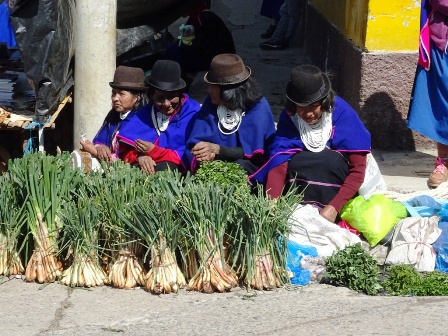
Click the photo above to see an album of the Silvia Tuesday Market. Close the window to return.
Read previous Episode: Cali or Next Episode: Zipaquira
January 25-27 2016
We lucked out. Our planned two night stay in Popoyán coincided with the weekly Tuesday Market in Silvia, the center of the Guambiano region, 53 km NE of Popoyán, The Guambiano people, who live in small mountain villages a distance from Silvia, are one of the most traditional indigenous groups in Colombia; they speak their own language, dress traditionally and farm using simple farming techniques. All the gringos who made it to Popoyán the previous evening, Ray and I included are in Silvia this morning for the market. We have come over the mountains on a public bus from Popoyán, a long 1 1/2 hour trip on the narrow mountain road.
Guambianos started arriving at daybreak, either walking over the hills, riding motorcycles, or more commonly, in chivas, colourful open-sided buses. The market is already in full swing, with sellers patiently displaying their wares and buyers looking for the freshest produce. It is a carnival of colour. The Guambianos do not like their picture taken, so we politely ask if we can photo their produce and every now and then, get a photo from a distance of the crowd of people.
I can't get over how reminiscent of Bolivian indigenous people the Guambianos are. The women sport the same bowler hat and full hand-woven navy blue skirt trimmed with white stripes. In Silvia the women add a bright blue shawl edged in pink and multiple beaded necklaces. Young girls are distinguished by their flat straw hat decorated colourfully and often sporting flowers. The men have the same bowler hat but wear a blue skirt, like a sarong, crossed over in the back with a pink fringe. The men also wear a dark blanket over their shoulders, also edged in pink. All wear sturdy work boots. A few women sit in the church plaza, taking a break from the market, spinning raw wool, not yet died that clear blue.
Ray and I edged our way around the closely packed stalls in the indoor market, amazed at the variety of potatoes and onions, some of which were unknown to us. Outside a group of men debated the merits of a few small pack horses and the few remaining piglets for sale. The streets surrounding the main market were lined with women with their produce artfully displayed against the curb.
Taking a break from the market, we walked through the streets of the small town to climb a small hill topped by a church, where we were treated to a 360 view of the area. We returned to Popoyán at the end of the morning, glad to have been a witness to perhaps a dying way of life.
After lunch in town we spent the rest of the afternoon wandering around Popoyán, admiring the well preserved Colonial architecture. Popoyán, nicknamed the La Ciudad Blanca for its wealth of white buildings, was founded in 1537 by Sebástien de Belálcazar. The town was the most important stopping point between Quito, Ecuador and Cartagena. Its mild climate attracted wealthy families from the sugar haciendas in the hot Cali region who built houses, schools and imposing churches and monasteries in the 17th C. Popoyán was the capital of southern capital for centuries until Cali overtook it.
Click the photo above to see an album of Popoyán. Close the window to return.
That night we shared dinner at The Italian Restaurant with Rick and Chris, new friends staying at the same Hotel Krone and with whom we shared the day in Silvia. We talked about the kindness of the hotel manager, Don Bernardo, who had personally driven all his clients to the bus station so that they could be sure to get on the correct bus to Silvia. Bernardo also repeated his kindness to Ray and I the next day when he insisted on driving us to airport for our flight back to Bogota. It was fitting to spend the last evening with good friends and good memories of our visit to Popoyán and Silvia.
|
Return to Columbia Intro
Return to Travels
Return to Introduction